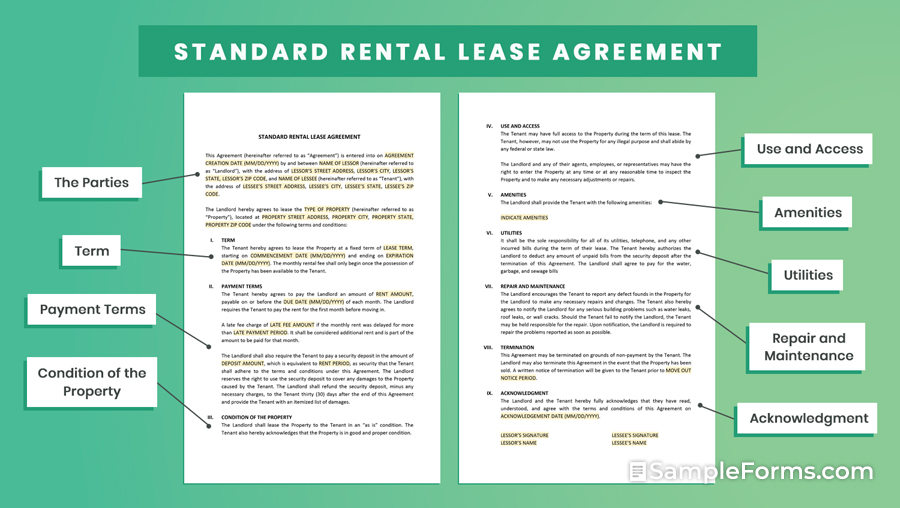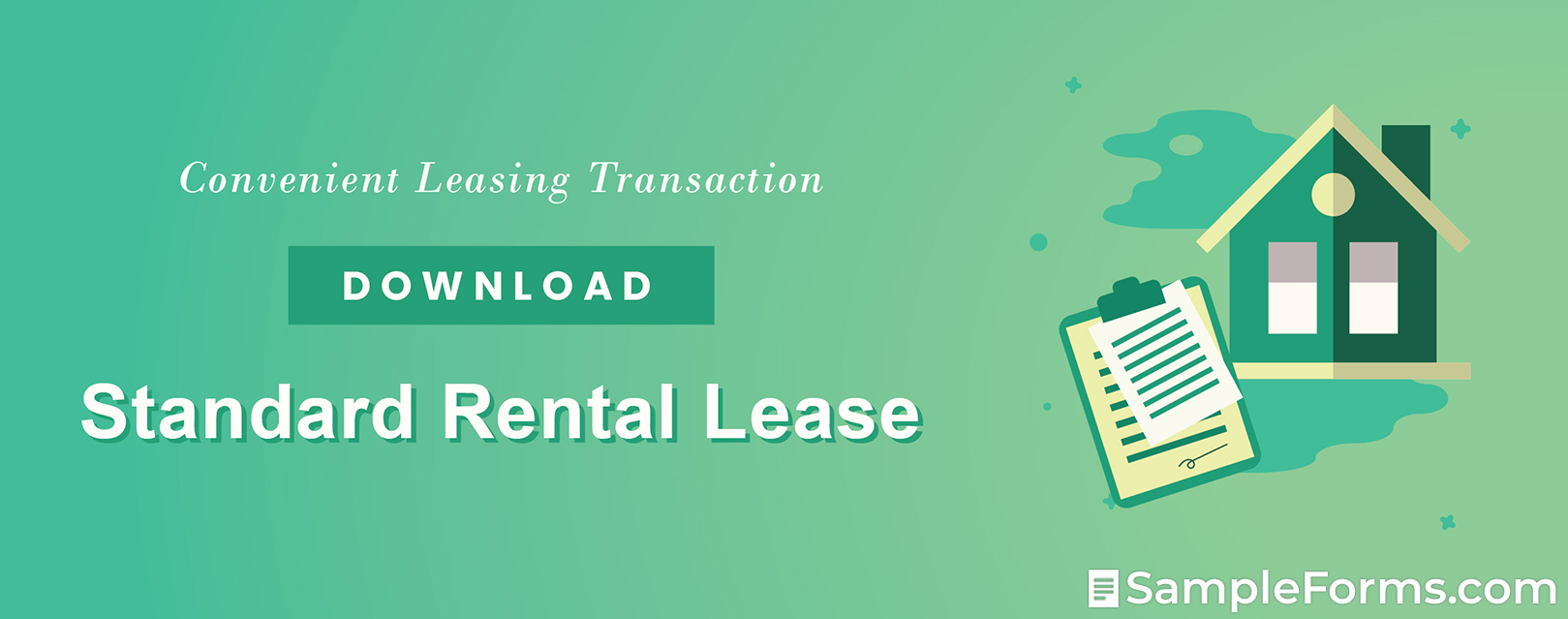- Eviction Notice Forms
- Power of Attorney Forms Forms
- Bill of Sale (Purchase Agreement) Forms
- Lease Agreement Forms
- Rental Application Forms
- Living Will Forms Forms
- Recommendation Letters Forms
- Resignation Letters Forms
- Release of Liability Agreement Forms
- Promissory Note Forms
- LLC Operating Agreement Forms
- Deed of Sale Forms
- Consent Form Forms
- Support Affidavit Forms
- Paternity Affidavit Forms
- Marital Affidavit Forms
- Financial Affidavit Forms
- Residential Affidavit Forms
- Affidavit of Identity Forms
- Affidavit of Title Forms
- Employment Affidavit Forms
- Affidavit of Loss Forms
- Gift Affidavit Forms
- Small Estate Affidavit Forms
- Service Affidavit Forms
- Heirship Affidavit Forms
- Survivorship Affidavit Forms
- Desistance Affidavit Forms
- Discrepancy Affidavit Forms
- Career Assessment - 16+ Examples, Format, Tips, Pdf Forms
- Undertaking Affidavit Forms
- General Affidavit Forms
- Affidavit of Death Forms
Standard Rental Lease Form
When people choose between buying or leasing a certain property, they usually come up with the pros and cons of each. For those who opt to rent know that leasing comes with advantages. So the importance of having a lease agreement. First off, leasing costs less than buying. Buying a property means paying additional taxes and maintenance fees. A standard lease or rental agreement contains the rules, guidelines, and conflict resolution process in a lessor-lessee relationship. Read More
Standard Rental Lease Form
What Is a Standard Rental/Lease Form?

As mentioned above, a standard rental or lease agreement form contains the basic terms and conditions that come with leasing a property. Generally, the lessor creates the document and include the details on how they want to maintain the property while the lessee is living in the area. On the note of being a standard form, it means that it uses the basic format of a lease or rental agreement. Other variations of the agreement are longer or more complex because of the several considerations that the landlord may choose to include in the agreement. But as for these standard forms, its stipulations are considered to be the essentials for any lease or rental agreement.
How Do You Create a Standard Rental/Lease Form?
The responsibility of creating the agreement form often falls to the landlord or lessor. So, if you are already in the business or is currently thinking of putting specific properties up for lease, our site presents a step by step process on how to create one. Knowing the process of creating the document is also helpful for tenants or lessees. If you are acquainted with the process, you know the parts of the document that you need to double-check before agreeing to the entire agreement.
1. State the Essence of the Agreement
The first part of this standard rental or lease agreement is the statement stating the purpose of the document. It introduces the agreement of the lessor and the lessee regarding a particular property. In essence, it declares that party A agrees to lease a particular property to party B. Write the specifications of both parties and the property, particularly the names and respective addresses.
2. Introduce the Payment and the Terms
Since the document is a lease agreement, the form must reflect the specific time frame of the arrangement. Both the starting or commencement date and end date or termination date are necessary. Other than these pieces of information, another important date needed is when the payment is due. This detail will be under the payment dues. It should go together with other payment-related information, such as payment deposit and late fee amount. Following conditions relating to these fees are also necessary for this part of the document.
3. Describe the Property and its Condition
It is not enough to merely mention the type of the property, and its address, further description of the present condition of the property is necessary. However, most standard lease agreements state that both parties agree to lease the property in its “as-is” condition. In this case, the lessee is aware of the current condition of the property and agrees to push through with the lease. You should also include a list of amenities if there are any.
4. State the Lessor’s Responsibilities
One of the perks of leasing a property is that the lessor takes care of the property’s maintenance and upkeep throughout the arrangement. So, it is just as important that the agreement must indicate the list of the lessor’s tasks and responsibilities regarding the matters above. These terms and conditions include the regulation regarding the lessor’s access to the area, as well as the schedule for repairs and maintenance.
5. Know the Bounds of Termination
The landlord can terminate the lease arrangement if the tenant fails to follow the guidelines stipulated in the agreement. Other reasons for premature termination of the agreement can be found in the latter part of the document under the condition of end. The most viable explanation for the arrangement’s termination is non-payment. As a lessee, it is your responsibility to memorize or familiarize the termination terms to avoid the early end of the whole deal.
FAQs
What can void a lease agreement?
A void legal document means that it is unenforceable the moment it was created. A lease agreement can be void if the grounds of creating such are illegal. One party can also request to void the agreement when coercion or fraudulent activities were present.
If worse comes to worst, it is better to be evicted or to break off the lease?
If met with unfavorable circumstances such as financial instability and you can no longer pay off your rent, it is better to talk to your landlord about breaking off the lease for this ground. Getting evicted from the property requires you to consult a lawyer and to take some time off to go to the court.
What are the legal reasons for breaking off a lease?
There are several reasons to sever a lease agreement legally. One acceptable ground is undue hardship. Financial instability or bankruptcy can fall under this. Another reason is when the premises prove to be uninhabitable. The last possible reason is when the landlord consistently fails to deliver their responsibility, as stated in the agreement.
What would happen if the lease is ended early?
In most cases, the lessee is most likely liable to pay for damages to the lessor. This happens when the tenant mistakenly believes that they can use the security deposit fee to pay off the rent for the last month’s stay. This mistake stems out if the tenant does not read through the agreement properly. Most security deposit fees are refundable when the tenant moves out.
What will happen if the dates on the lease are wrong?
If the dates reflected on the lease are not the same as the date that you agreed with your lessor, then both parties are bound to follow the date stated on the document.
Reading through agreement may seem to be a daunting task for some because this word is associated with civil liabilities and responsibilities. Although this is true that agreements can make one civilly liable for certain obligations, it is merely a rule book on how to live in a rented or leased property. Taking away the civil implications, it contains rules, conditions, and terms regarding the responsibilities of the lessor and lessee.

